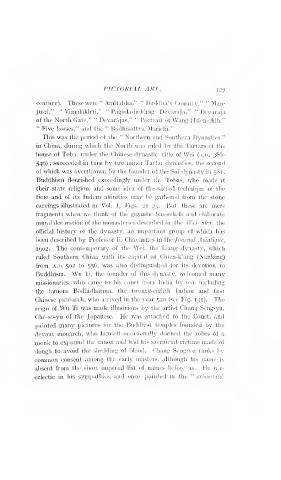Page 383 - Chinese Art, Vol II By Stephen W. Bushell
P. 383
PICTORIAL ART. lij
Century). These were " Amitabha," "Buddha's Country," " Man-
" " "
jusri," Vimalakirti," Pagoda-holding Devanija," Devaraja
of the North Gate," " Devarajas," " Portrait of Wang Hsien-chih,"
" Five horses," and the " Bodhisattva Marichi."
This was the period of the " Northern and Southern Dynasties "
in China, during which the North was ruled by the Tartars of the
house of Toba, under the Chinese dynastic title of Wei (a.d. 386-
549) ; succeeded in turn by two minor Tartar dynasties, the second
of which was overthrown by the founder of the Sui dynasty in 581.
Buddhism flourished exceedingly under the Tobas, who made it
their state religion, and some idea of the sacred technique of the
time and of its Indian affinities may be gathered from the stone
carvings illustrated in Vol. I, Figs. 21-23. But these are mere
fragments when we think of the gigantic bas-reliefs and elaborate
mural decoration of the monasteries described in the Wei Shu, the
official history of the dynasty, an important group of which has
been described by Professor E. Chavannes in iht Journal Asiatique,
igo2. The contemporary of the Wei, the Liang dynasty, which
ruled Southern China with its capital at Chien-k'ang (Nanking)
from A.D. 502 to 556, was also distinguished for its devotion to
Buddhism. Wu Ti, the founder of this dynasty, welcomed many
missionaries, who came to his court from India by sea, including
the famous Bodhidharma, the twenty-eighth Indian and first
Chinese patriarch, who arrived in the year 520 (see Fig. 131). The
reign of Wu Ti was made illustrious by the artist Chang Seng-yu,
Cho-so-yu of the Japanese. He was attached to the Court, and
painted many pictures for the Buddhist temples founded by the
devout monarch, who himself occasionally donned the robes of a
monk to expound the canon and had his sacrificial victims made of
dough to avoid the shedding of blood. Chang Seng-yu ranks by
common consent among the early masters, although his name is
absent from the short imperial list of names before us. He was
eclectic in his sympathies, and once painted in the " arbor-vitce

